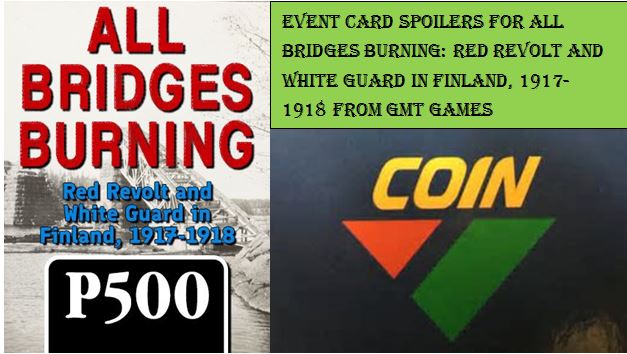Through our interactions with VPJ Arponen, the designer for COIN Series Volume X All Bridges Burning: Red Revolt and White Guard in Finland, 1917-1918, we have become very interested in the game and its design. We did an interview with him on the design, which was posted to our blog in early February, and also worked with him last year to do a series of posts on his work with the solo bots for various other games, including Colonial Twilight and Hitler’s Reich. In this new feature, we have asked Vez to provide us with text of some of the proposed Event Cards and also to give a short summary of the historical background as well as their use in the game. We will plan to post these Spoilers every 7-10 days over the next few months, or even longer if Vez is up for it. Please keep in mind that the artwork and layout of these cards is not yet finalized and is only for playtest purposes at this point.
3. November Revolution in Russia
The year 1917 saw the collapse of Tsarism in Russia which had inevitable effects on life  in Finland, at the time a semi-autonomous province of Russia. The event simulates two different kinds of scenarios resulting from the instability in Russia.
in Finland, at the time a semi-autonomous province of Russia. The event simulates two different kinds of scenarios resulting from the instability in Russia.
On the one hand, the troubles in Russia gave raise to a growing power vacuum in Finland which the Red Guards of the working class movement on the one hand, and the White Guards of the political right or the bourgeoisie on the other, sought to fill. The event card simulates this effect in certain ways.
The factions may use the lower part of the event to activate a 1d6 of their own cells – cells being the pieces that many previous COIN Series volumes know as guerrillas. In All Bridges Burning, the activation of a faction’s own cells represents the radicalization of the faction’s supporters, their preparedness to actively engage for the cause of the faction. The activation of a cell enables the faction, among others, to use the cell for carrying out the Terror command as well as to Agitate for more opposition or support.
The non-violent Moderates, by contrast, could use this event to hide their own cells – hiding somewhat corresponding to the underground status of guerrillas in the previous volumes. The Moderates cells, in contrast to the Senate and the Reds cells, will want to remain hidden, a state which enables many of their most consequential actions.
On the other hand, the top part of the event text allows a faction to shift Russian Vassalage, to either decrease or increase it – the level of Russian Vassalage determines the number of Russian Troops on the map affecting thus the level of the military resistance that the Reds can put up against the Senate and the Germans. From the game design perspective the playing of this event can serve as an early indication of how the Reds and the Senate faction orientate themselves strategically in the game. The Senate faction would probably be interested in using this event to decrease Russian involvement in the conflict, thereby weakening the Reds’ military capabilities, while the Reds might want to play the event to the opposite effect. There’s a catch there for the Reds player, however. At the game end, the level of foreign involvement can return to haunt the players in that a part of the Reds and Senate victory conditions is a certain low level of foreign vassalage.
Next card up in the series will be #8. General Strike.
-Grant
